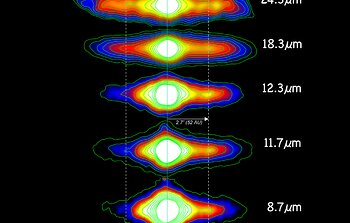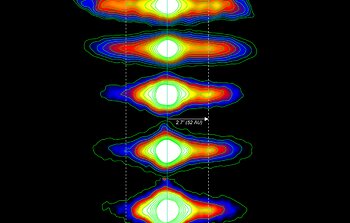Dusting for Clues: Gemini Discovers Evidence for Colliding Bodies in Planet Forming Disk
January 13, 2005

Astronomers using the Gemini South 8-meter telescope in Chile have observed new details in the dusty disk surrounding the nearby star Beta Pictoris which show that a large collision between planetary-sized bodies may have occurred there as recently as the past few decades.
The mid-infrared observations provide the best evidence yet for the occurrence of energetic encounters between planetesimals during the process of planetary formation.
"It is as if we were looking back about 5 billion years and watching our own solar system as it was forming into what we see today," said Dr. Charles Telesco of the University of Florida who led the team. "Our research is a bit like a detective dusting for fingerprints to figure out a crime scene, only in this case we use the dust as a tracer to show what has happened within the cloud. The properties of the dust show not only that this was a huge collision, but that it probably happened recently in both astronomical and even human timescales."
The team’s data revealed a significantly higher concentration of small dust grains in one region of the debris disk that gave Beta Pictoris a lopsided appearance in previous observations. According to team member Dr. Scott Fisher of the Gemini Observatory, it is the unique properties of this fine dust that allows speculation on the timing of this collision. "Many of us remember pounding chalk dust out of erasers in school,” he said. “After you sneeze a few times, you open a window and the fine dust blows away. In Beta Pictoris, the radiation from the star will blow away the fine particles created by the collision quite rapidly. The fact that we still see them in our observations means that the collision probably happened in the past 100 years or so. Almost assuredly my grandparents were alive when this collision occurred.”
Computer models done at the University of Florida by team members Dr. Stanley Dermott, Dr. Tom Kehoe and Dr. Mark Wyatt (of the Royal Observatory, Edinburgh, UK) show that the timescales necessary to remove this fine dust in Beta Pictoris are on the order of decades. "This process moves out the smaller dust particles very quickly and leaves behind the larger debris," said Dermott. "The larger particles will eventually disperse throughout the cloud as it orbits around the central star and the bright clump we see now will essentially dissolve into the disk."
Disks of material surrounding stars such as Beta Pictoris are thought to contain objects of all sizes, from small dust grains similar to household dust to large planetesimals, or developing planets. As all of these objects orbit around the star, just like the Earth circles the Sun, they occasionally collide. The largest of these catastrophic encounters leave behind tell-tail debris clouds of fine dust observable at infrared wavelengths. By collecting high-resolution images from across a broad swath of the thermal infrared part of the spectrum, the research team from the US, UK and Chile was able to study such a cloud within the larger Beta Pictoris disk and analyze the images to determine the spatial distribution and estimate the size of the debris particles in the post-collision aftermath.
A collision similar to this one may well have created our own Moon several billion years ago when a Mars-sized body collided with what would eventually become the Earth. While the Moon itself formed out of large rocks and debris created by the collision, the small dust particles were blown away by radiation pressure from the young Sun. In the Beta Pictoris system radiation from the central star blows at about 15 times the intensity of the Sun, clearing out small grains even more quickly.
Because the Beta Pictoris disk is oriented to us edge-on, the observed asymmetry is visible as a bright “clump” in the cigar-shaped cloud of material orbiting the central star. The Gemini images also reveal new structures in the disk that might show where planets are forming in the system. The team is still studying these features, and follow-up observations are planned using Gemini South’s newly silver-coated 8-meter mirror. This silver coating (now on both Gemini telescopes) makes the twin telescopes the most powerful facilities on Earth for this type of infrared research.
Beta Pictoris was one of the first "circumstellar" disks discovered by astronomers. It was initially detected in IRAS (Infrared Astronomy Satellite) data in 1983 by a team led by Dr. Fred Gillett (formerly Gemini’s Lead Scientist) and then imaged by Dr. Bradley Smith and Dr. Richard Terrile. Its lopsided nature was apparent even then, but until recently, observations yielded insufficient data at high-enough resolutions to show the clumpy nature of this asymmetry and estimate the relative particle distribution in the cloud.
The Gemini data were obtained using the Gemini Thermal-Region Camera Spectrograph (T-ReCS) on the Gemini South Telescope on Cerro Pachón in Chile.
The international team published their findings and conclusions in the January 13 issue of the journal Nature and in San Diego, California at the 205th meeting of the American Astronomical Society.
Contacts
Peter Michaud
pmichaud@gemini.edu
(808) 974-2510 (desk)
(808) 937-0845 (cell)
Gemini Observatory
Hilo HI, USA
Scott Fisher
sfisher@gemini.edu
Phone: 808/974-2615
Gemini Observatory - Hilo
















